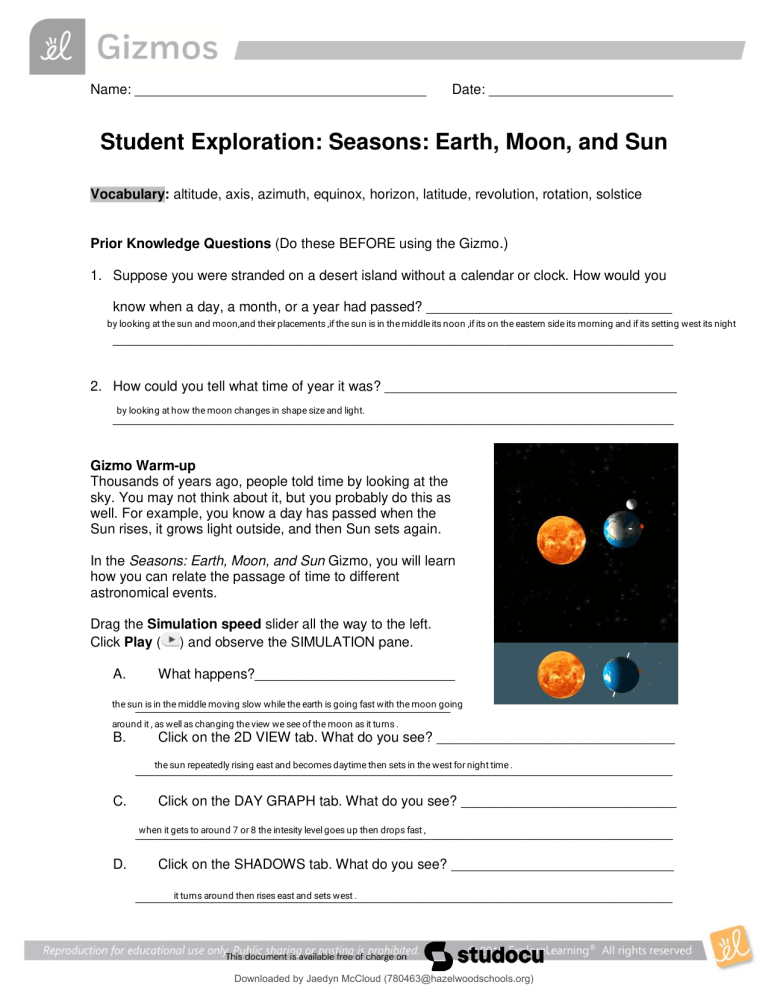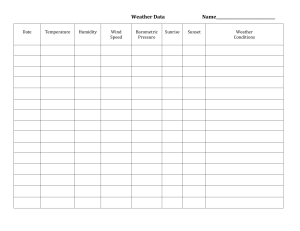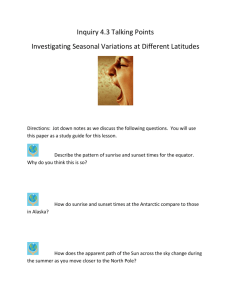
lOMoARcPSD|12397694 Name: ______________________________________ Date: ________________________ Student Exploration: Seasons: Earth, Moon, and Sun Vocabulary: altitude, axis, azimuth, equinox, horizon, latitude, revolution, rotation, solstice Prior Knowledge Questions (Do these BEFORE using the Gizmo .) 1. Suppose you were stranded on a desert island without a calendar or clock. How would you know when a day, a month, or a year had passed? ________________________________ by looking at the sun and moon,and their placements ,if the sun is in the middle its noon ,if its on the eastern side its morning and if its setting west its night _________________________________________________________________________ 2. How could you tell what time of year it was? ______________________________________ by looking at how the moon changes in shape size and light. _________________________________________________________________________ Gizmo Warm-up Thousands of years ago, people told time by looking at the sky. You may not think about it, but you probably do this as well. For example, you know a day has passed when the Sun rises, it grows light outside, and then Sun sets again. In the Seasons: Earth, Moon, and Sun Gizmo, you will learn how you can relate the passage of time to different astronomical events. Drag the Simulation speed slider all the way to the left. Click Play ( ) and observe the SIMULATION pane. A. What happens?__________________________ the sun is in the middle moving slow while the earth is going fast with the moon going _________________________________________ around it , as well as changing the view we see of the moon as it turns . B. Click on the 2D VIEW tab. What do you see? _______________________________ the sun repeatedly rising east and becomes daytime then sets in the west for night time . ______________________________________________________________________ C. Click on the DAY GRAPH tab. What do you see? ____________________________ when it gets to around 7 or 8 the intesity level goes up then drops fast , ______________________________________________________________________ D. Click on the SHADOWS tab. What do you see? _____________________________ it turns around then rises east and sets west . ______________________________________________________________________ 2019 Downloaded by Jaedyn McCloud (780463@hazelwoodschools.org) lOMoARcPSD|12397694 Activity A: Days, months, and years Get the Gizmo ready: Click Reset ( ). Select the 2D VIEW tab. Question: What astronomical events coincide with the passage of a day, month, or year? 1. Observe: Click Play. Observe how the position of the red dot in the SIMULATION pane relates to the cycle of night and day on the 2D VIEW tab. What astronomical event causes day and night? __________________________________ when the red dot points at the sun its day and when it faces away its night . _________________________________________________________________________ Every time Earth finishes one rotation on its axis, a complete cycle of day and night occurs. In the SIMULATION pane, Earth’s axis is represented by the red line that goes through the center of the planet. 2. Describe: Months are another unit of time based on an astronomical event. Click Reset, and move the Simulation speed slider to the right a quarter of the way. Click Play, and observe the movements of Earth and the Moon for one month. (Note: You can use the calendar in the upper right corner of the 2D VIEW tab to determine when a month has passed.) A. Describe the movements of Earth and the Moon over the course of a month. the earth moves fast and the moon moves slower while revolving around the earth. ___________________________________________________________________ B. What astronomical event corresponds to the passage of one month? the time the month started the moon was facing twoards the sun and away from the earth, so there was no moon at night but as the days went ___________________________________________________________________ on the moon phases changed and the moon began to show up more. It takes approximately 28 days for the Moon to revolve around Earth. Revolution is the elliptical motion of a body traveling around another body in space. 3. Diagram: Click Reset. Set the Simulation speed to maximum. Click Play, and observe the movement of Earth over the course of one year. In the diagram below, draw how the position of Earth changes. A. What astronomical event corresponds to the passage of 1 year? _______________ _________________________________ it tsakes earth one year to revolve arounf the sun _________________________________ B. How long does it take Earth to revolve 365 days around the Sun? ____________________ 2019 Downloaded by Jaedyn McCloud (780463@hazelwoodschools.org) lOMoARcPSD|12397694 Activity B: Sun’s path Get the Gizmo ready: Click Reset. Set the Simulation speed to minimum. Question: What causes the Sun to appear to move in a path across the sky? 1. Observe: Select the 2D VIEW tab. Click Play, and watch the apparent motion of the Sun across the sky. In the diagram at right, draw an arrow to show the Sun’s direction and path. Mark the highest altitude the Sun reaches with an X. Altitude is the distance an object appears to be above the horizon. The horizon is the line along which the sky and the Earth appear to meet. 2. Make a rule: On the 2D VIEW tab, E stands for east and W stands for west. Knowing this, you can conclude that the Sun rises in the __________ and sets in the __________. e w 3. Analyze: The Sun’s azimuth is the direction of the Sun in the sky. Azimuth is measured in degrees. Look at the diagram. A. What is the Sun’s approximate azimuth when it 90 rises? ____________________________________ B. What is the Sun’s approximate azimuth when it sets? 270 _________________________________________ 4. Summarize: Select the SHADOWS tab. Click Play, and observe the Azimuth. How does the Sun’s azimuth change over the course of the day? it goes really fast from east west to south over the course of the day _________________________________________________________________________ _________________________________________________________________________ 5. Describe: Click Reset. Select the 2D VIEW tab. On the SIMULATION pane, the red dot on Earth represents where the observer who is seeing the scene on the 2D VIEW tab is standing. Describe the position of the red dot in the SIMULATION pane at midnight. they are standing at the north point at midnight . _________________________________________________________________________ (Activity B continued on next page) 2019 Downloaded by Jaedyn McCloud (780463@hazelwoodschools.org) lOMoARcPSD|12397694 Activity B (continued from previous page) 6. Observe: Click Play. When the Sun begins to rise on the 2D VIEW, click Pause ( ). How the red dot is positioned in the east has the position of the red dot changed? ________________________________________ _________________________________________________________________________ 7. Observe: Click Play again. When the Sun begins to set on the 2D VIEW, click Pause. How the red dot isnt as visible in the west view has the position of the red dot changed? ________________________________________ _________________________________________________________________________ 8. Draw conclusions: What causes the apparent motion of the Sun across the sky: the movement of Earth or the movement of the Sun? Explain. ___________________________ the movement of the earth. _________________________________________________________________________ 8. Predict: A shadow is caused when an object blocks sunlight. For example, when your body blocks sunlight, you may see a shadow of yourself on the ground. How do you think the shadow of an object, such as a flagpole, would change over the course of the day as the Sun appears to move across the sky? _________________________________________________________________________ the position of the sun will affect change in size and direction of the object . _________________________________________________________________________ 9. Observe: Click Reset. Select the SHADOWS tab, and click Play. Observe the Overhead and Projection view of the Shadow of a stick. What do you notice? ________________________________________________________ it goes super fast between east and west _________________________________________________________________________ 10. Compare: As you watch the shadow move, observe how its length changes in comparison to the Altitude of the Sun. A. Describe the length of the shadow when the Sun is at its highest altitude. the shorter are the shadows produced ___________________________________________________________________ B. Why does the Sun’s altitude affect shadow length? __________________________ More blocked light makes shadows longer. ___________________________________________________________________ 2019 Downloaded by Jaedyn McCloud (780463@hazelwoodschools.org) lOMoARcPSD|12397694 Activity C: Get the Gizmo ready: Sunrise and sunset times Click Reset. Select the DESCRIPTION tab. Set the Simulation speed to minimum. Question: What factors affect sunrise and sunset times? 1. On your own: Latitude is a location’s distance north or south of the equator. You can use Google™ or another search engine to look up your town’s latitude. 38.627003 What is the latitude of your town? _____________________________________________ Use the Latitude slider on the DESCRIPTION tab to set the Gizmo to your town’s latitude. 2. Collect data: Select the GRAPH tab and check that Day graph is selected. Click Play, and observe. The solar intensity curve goes up at sunrise and goes down at sunset. Click Reset. Use the red date slider at lower right to set the date to March 21. Click Play, and then click Pause after the sun sets. Use the Day graph to record the approximate sunrise and sunset times in the table below. (Note: The Gizmo does not take Daylight Saving Time into account.) Date Sunrise Time March 21 June 21 September 23 December 21 6am 5am Sunset Time 12hr 6pm 7pm 16hr 6am 6pm 8 am Hours of Daylight 12hr 5pm 9hr Click Reset, and repeat the activity above for the other dates listed in the table. Then calculate the hours of daylight for each of the four dates. 3. Compare: How do sunrise times, sunset times, and hours of daylight change over the course of the year? _________________________________________________________ non-circularity of the orbit and the tilt of the Earth's axis of rotation both contribute to the uneven changes in the times of sunrise and sunset. _________________________________________________________________________ 4. Analyze: Equinoxes are dates on which the daytime lasts as long as the nighttime. Solstices are the dates of the longest and shortest daytimes of the year. march and sept A. Which two dates are equinoxes? ______________________________________ B. How does the amount of daylight during the summer solstice (June 21) compare to 5hrs that on the winter solstice (December 21)? _________________________________ (Activity C continued on next page) 2019 Downloaded by Jaedyn McCloud (780463@hazelwoodschools.org) lOMoARcPSD|12397694 Activity C (continued from previous page) 5. Diagram: Click Reset. Move the date slider to each of the equinox and solstice dates. Examine how moving the date slider makes the position of Earth on the SIMULATION pane change. In the diagram at right, mark Earth’s position and the position of Earth’s axis on each date. Shade in the part of Earth not lit by the Sun. 6. Compare: Use the SHADOWS tab to compare the Altitude of the Sun on the summer and winter solstices. Draw the highest altitude the Sun reaches on each of those two dates in the graphs at right. June 21 December 21 On which date does the Sun reach the june 21st highest altitude? _______________________ 7. Collect data: Use the observations you have made to answer the following question: What do you think causes the changes in sunrise and sunset times over the course of the year? The tilt of the Earth's axis as it rotates and orbits around the sun _________________________________________________________________________ _________________________________________________________________________ 8. Hypothesize: How do you think latitude affects sunrise and sunset times? ______________ As latitude increases, sunrises occur later. _________________________________________________________________________ 9. Collect data: Select the DESCRIPTION tab. Move the Latitude slider back and forth to see how it changes the red dot’s position in the SIMULATION pane. Latitude 89° none 45° Click Reset. Set the latitude to 89°. Then use the DAY GRAPH tab to fill in the table for January 1. Repeat for the other latitudes listed in the table. Sunrise Time 8am 0° Sunset Time none 5pm 6 am -45° 5 am -89° none 8pm none What causes the differences between the sunrise and sunset times at different latitudes? non-circularity of the orbit and the tilt of the Earth's axis of rotation _________________________________________________________________________ _________________________________________________________________________ 2019 Downloaded by Jaedyn McCloud (780463@hazelwoodschools.org)


